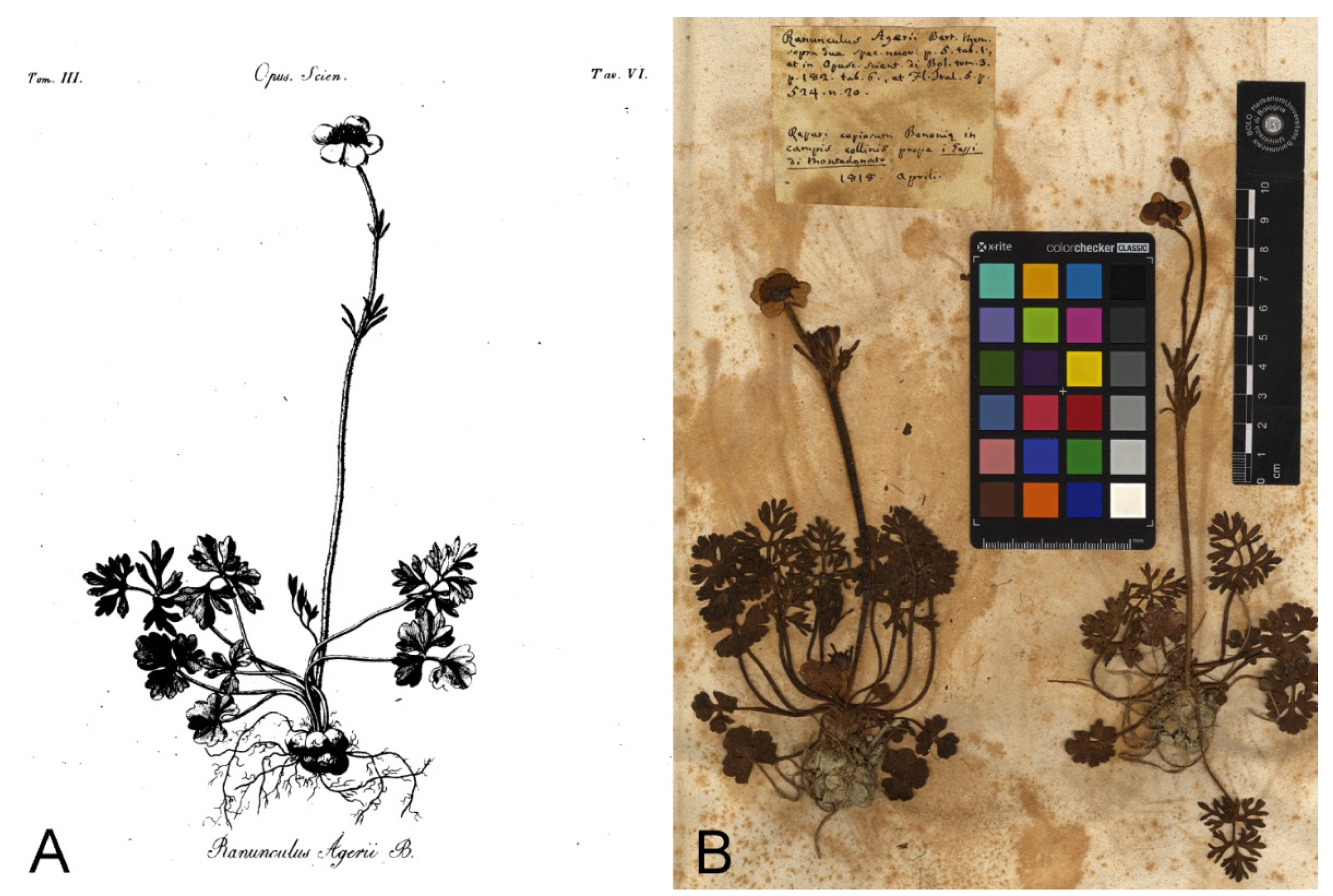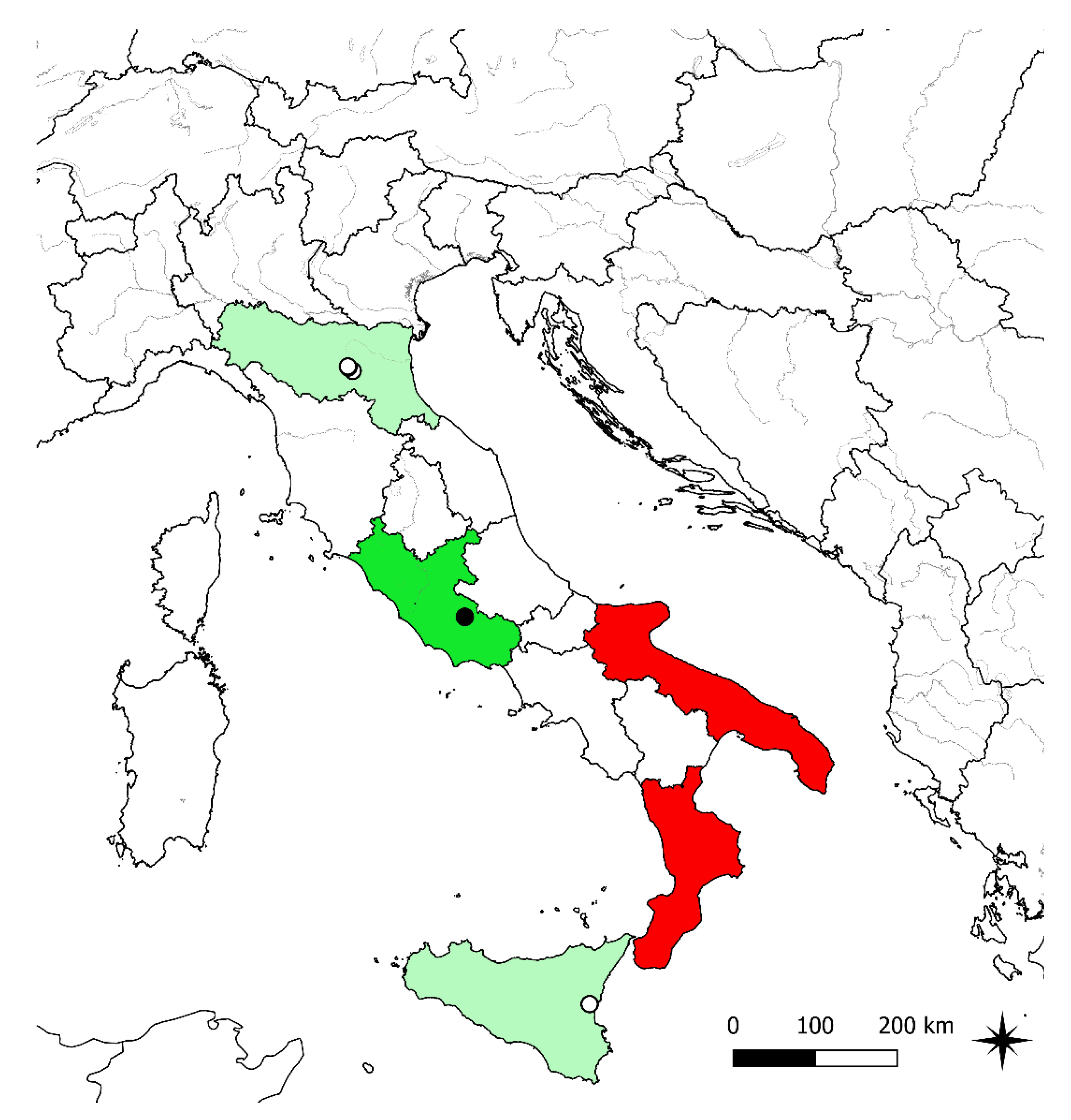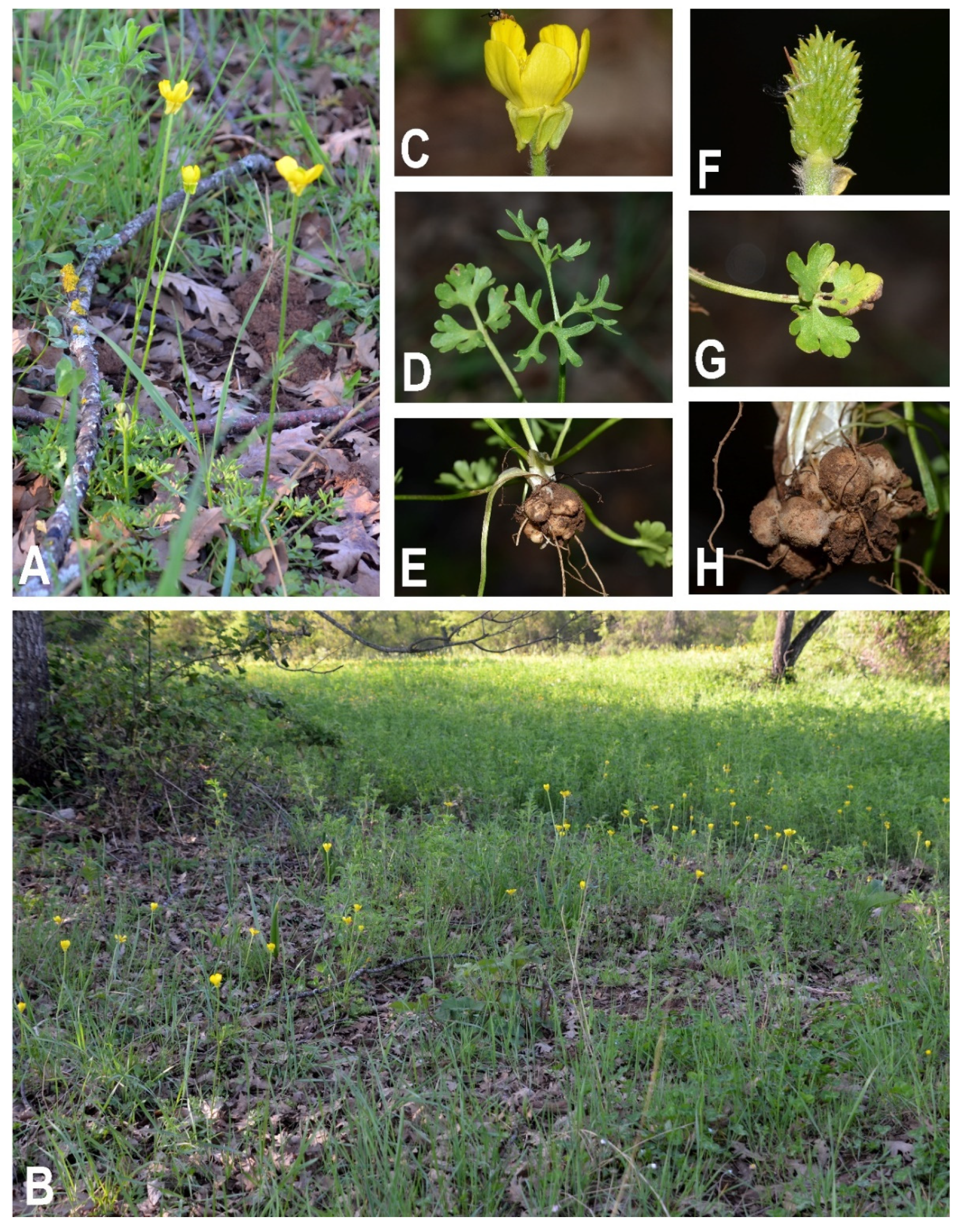Nomenclatural Synopsis, Revised Distribution and Conservation Status of Ranunculus gracilis (Ranunculaceae) in Italy
Abstract
1. Introduction
2. Materials and Methods
3. Results
3.1. The Long and Controversial History of R. gracilis in Italy
3.2. Typification of the Names
3.2.1. Ranunculus agerii Bertol., Opusc. Sci. 3: 182. 1819
3.2.2. Ranunculus gracilis E.D.Clarke, Travels Eur. Asia and Africa 3 part 2(2): 336. 1814
3.2.3. Ranunculus schowii Tineo, in Gussone Fl. Sicul. Syn. 2(2): 889. 1845. [1 January–September 1845]
3.3. Taxonomic Treatment
- Emilia-Romagna: the presence of the species is confirmed by several old herbarium specimens kept in BOLO, CHE, FI, G, P, PI and RO (see specimens examined). Furthermore, the 16th century samples preserved in the “En Tibi” and “Cibo” herbaria were also collected in Emilia-Romagna near Bologna (Stefanaki et al. 2018, 2019). No recent herbarium samples or bibliographic records have been found (see, [55]); therefore, the species should be considered as no longer recorded. Targeted field research will be needed before considering the species as locally extinct.
- Toscana: the species was never recorded for the region. We traced an old herbarium specimen in FI, collected in the Botanical Garden of the University of Firenze, where the species was probably cultivated.
- Lazio: during field investigations carried out in the territory of Anagni (Frosinone, Central Italy) in March and April 2022, we discovered the species on Mt. Campitelli (Figure 4). Our finding corroborates the old report for this area by Sibilia ([56], under the name R. agerii) and confirms the presence of this species in Italy. The Sibilia record has never been incorporated in the regional floras [4,57,58,59]. In the current state of knowledge, this is the only population present in Italy.
- Calabria: according to Peruzzi and Passalacqua [41], the Calabrian records should be referred to R. monspeliacus subsp. aspromontanus.
- Sicily: the species was reported in Sicily from different localities by Giardina et al. [12]: between Vittoria and Terranova based on the description of R. schowii [18], between Catania and Misterbianco based on Strobl [61] and from Polizzi Generosa [62]. We have shown that R. schowii is not related to R. gracilis; therefore, the report of the latter between Vittoria and Terranova is erroneous. We traced, in PAL, the sample collected in Polizzi Generosa (“sotto il paese di Polizzi Generosa vicino all’acquedotto, 30 April 1990, Raimondo and Certa”), which should be referred to R. paludosus. A specimen cited in Wikiplantbase Sicilia [63] as R. gracilis and stored in PAL (No. 43515) collected at Busambra belongs to R. paludosus as well as a specimen in CAT No. 048272 (Monte Lauro, 9/V/1991, Brullo et al.). The only datum that we were able to confirm is the indication by Strobl [61], for the Amenano between Catania and Misterbianco at the foot of Etna, thanks to the tracing of an old herbarium sample stored in FI, collected in 1874 by Heidenreich at Misterbianco (quoted also by Fiori et al. [10]). Based on our data, R. gracilis should be considered as no longer recorded in Sicily. Targeted field research will be needed before considering the species as locally extinct.
4. Conclusions
Author Contributions
Funding
Institutional Review Board Statement
Informed Consent Statement
Data Availability Statement
Acknowledgments
Conflicts of Interest
References
- Tamura, M. Angiospermae. Ordnung Ranunculales. Fam. Ranunculaceae. II. Systematic part. IV 17A. In Die natürlichen Pflanzenfamilien, 2nd ed.; Hiepko, P., Ed.; Duncker Humblot: Berlin, Germany, 1995; pp. 223–519. [Google Scholar]
- Hörandl, E.; Emadzade, K. Evolutionary classification: A case study on the diverse plant genus Ranunculus L. (Ranunculaceae). Perspect. Plant Ecol. Evol. Syst. 2012, 14, 310–324. [Google Scholar] [CrossRef]
- Peruzzi, L.; Conti, F.; Bartolucci, F. An inventory of vascular plants endemic to Italy. Phytotaxa 2014, 168, 1–75. Available online: https://docs.google.com/spreadsheets/d/18SCKlDJ8TQHNm58td5j94UCZpymUPlwDZ5Yx9718MXE/edit#gid=4 (accessed on 10 September 2022). [CrossRef]
- Bartolucci, F.; Peruzzi, L.; Galasso, G.; Albano, A.; Alessandrini, A.; Ardenghi, N.; Astuti, G.; Bacchetta, G.; Ballelli, S.; Banfi, E.; et al. An updated checklist of the vascular flora native to Italy. Plant Biosyst. 2018, 152, 179–303. [Google Scholar] [CrossRef]
- Galasso, G.; Conti, F.; Peruzzi, L.; Ardenghi, N.M.G.; Banfi, E.; Celesti-Grapow, L.; Albano, A.; Alessandrini, A.; Bacchetta, G.; Ballelli, S.; et al. An updated checklist of the vascular flora alien to Italy. Plant Biosyst. 2018, 152, 556–592. [Google Scholar] [CrossRef]
- Clarke, E.D. Travels in Various Countries of Europe, Asia and Africa: Greece, Egypt, and the Holy Land; R. Watts for Cadell and Davies: London, UK, 1814; Volume 3, Part 2. [Google Scholar]
- Hörandl, E.; von Raab-Straube, E.; Ranunculeae. Euro+Med Plantbase—The Information Resource for Euro-Mediterranean Plant Diversity. 2015. Available online: https://europlusmed.org/cdm_dataportal/taxon/d6c91320-a11e-4069-b29a-51b6073596dd (accessed on 30 September 2022).
- POWO—Plants of the World Online, Facilitated by the Royal Botanic Gardens, Kew. Available online: http://www.plantsoftheworldonline.org/ (accessed on 20 July 2022).
- Pignatti, S.; Guarino, R.; La Rosa, M. (Eds.) Flora d’Italia, 2nd ed.; New Business Media: Milan, Italy, 2017; Volume 1. [Google Scholar]
- Fiori, A.; Béguinot, A.; Paoletti, G. Flora Analitica d’Italia; Tipografi del Seminario: Padova, Italy, 1898; Volume 1, pp. 257–607. [Google Scholar]
- Fiori, A. Nuova Flora Analitica d’Italia; Tipografia di M. Ricci: Firenze, Italy, 1924; Volume 1, pp. 641–800. [Google Scholar]
- Giardina, G.; Raimondo, F.M.; Spadaro, V. A catalogue of plants growing in Sicily. Bocconea 2007, 20, 5–582. [Google Scholar]
- Bertoloni, A. Memoria di Antonio Bertoloni professore di botanica nell’università di Bologna sopra due specie nuove di piante italiane. Opusc. Sci. 1819, 3, 180–186. [Google Scholar]
- Tutin, T.G. Ranunculus L. In Flora Europaea; Tutin, T.G., Burges, N.A., Chater, A.O., Edmondson, J.R., Heywood, V.H., Moore, D.M., Valentine, D.H., Walters, S.M., Webb, D.A., Eds.; Cambridge University Press: Cambridge, UK, 1964; Volume 1, pp. 223–238. [Google Scholar]
- Pignatti, S. Flora d’Italia; Edagricole: Bologna, Italy, 1982; Volume 1. [Google Scholar]
- Jalas, J.; Suominen, J. (Eds.) Atlas Florae Europaeae. Distribution of Vascular Plants in Europe. Nymphaeaceae to Ranunculaceae; The Committee for Mapping the Flora of Europe and Societas Biologica Fennica Vanamo: Helsinki, Finland, 1989; Volume 8, 261p. [Google Scholar]
- Tutin, T.G.; Akeroyd, J.R. Ranunculus L. In Flora Europaea, 2nd ed.; Tutin, T.G., Burges, N.A., Chater, A.O., Edmondson, J.R., Heywood, V.H., Moore, D.M., Valentine, D.H., Walters, S.M., Webb, D.A., Eds.; Cambridge University Press: Cambridge, UK, 1993; Volume 1, pp. 269–287. [Google Scholar]
- Gussone, G. Florae Syculae Synopsis; Tramater: Napoli, Italy, 1845; Volume 2. [Google Scholar]
- Domina, G.; Giusso del Galdo, G.; Gargano, D.; Labra, M.; Peccenini, S.; Peruzzi, L.; Raimondo, F.M. The Italian Loci Classici census. Taxon 2012, 61, 1351–1354. [Google Scholar] [CrossRef]
- Peruzzi, L.; Domina, G.; Bartolucci, F.; Galasso, G.; Peccenini, S.; Raimondo, F.M.; Albano, A.; Alessandrini, A.; Banfi, E.; Barberis, G.; et al. An inventory of the names of vascular plants endemic to Italy, their loci classici and types. Phytotaxa 2015, 196, 1–217. [Google Scholar] [CrossRef]
- Peruzzi, L.; Galasso, G.; Domina, G.; Bartolucci, F.; Santangelo, A.; Alessandrini, A.; Astuti, G.; D’Antraccoli, M.; Roma-Marzio, F.; Ardenghi, N.M.G.; et al. An inventory of the names of native, non-endemic vascular plants described from Italy, their loci classici and types. Phytotaxa 2019, 410, 1–215. [Google Scholar] [CrossRef]
- Brundu, G.; Peruzzi, L.; Domina, G.; Bartolucci, F.; Galasso, G.; Peccenini, S.; Raimondo, F.M.; Albano, A.; Alessandrini, A.; Banfi, E.; et al. At the intersection of cultural and natural heritage: Distribution and conservation of the type localities of the Italian endemic vascular plants. Biol. Conserv. 2017, 214, 109–118. [Google Scholar] [CrossRef]
- Thiers, B. Index Herbariorum: A Global Directory of Public Herbaria and Associated Staff. Available online: http://sweetgum.nybg.org/science/ih/ (accessed on 20 July 2022).
- Stafleu, F.A.; Cowan, R.S. Taxonomic Literature: A Selective Guide to Botanical Publications and Collections with Dates, Commentaries and Types, 2nd ed.; Bohn, Scheltema & Holkema: Utrecht, The Netherlands, 1976; Volume 1. [Google Scholar]
- Stafleu, F.A.; Cowan, R.S. Taxonomic Literature: A Selective Guide to Botanical Publications and Collections with Dates, Commentaries and Types, 2nd ed.; Bohn, Scheltema & Holkema: Utrecht, The Netherlands, 1986; Volume 6. [Google Scholar]
- Turland, N.J.; Wiersema, J.H.; Barrie, F.R.; Greuter, W.; Hawksworth, D.L.; Herendeen, P.S.; Knapp, S.; Kusber, W.-H.; Li, D.-Z.; Marhold, K.; et al. International Code of Nomenclature for Algae, Fungi, and Plants (Shenzhen Code) Adopted by the Nineteenth International Botanical Congress Shenzhen, China, July 2017; Regnum Vegetabile; Koeltz Botanical Books: Glashütten, Germany, 2018. [Google Scholar] [CrossRef]
- Stefanaki, A.; van Thijsse, G.; Ufellen, G.; van Eurlings, M.; Andel, T. The En Tibi herbarium, a 16th century Italian treasure. Bot. J. Linn. Soc. 2018, 187, 397–427. [Google Scholar] [CrossRef]
- Stefanaki, A.; Porck, H.; Grimaldi, I.M.; Thurn, N.; Pugliano, V.; Kardinaal, A.; Salemink, J.; Thijsse, G.; Chavannes-Mazel, C.; van Kwakkel, E.; et al. Breaking the silence of the 500-year-old smiling garden of everlasting flowers: The En Tibi book herbarium. PLoS ONE 2019, 14, e0217779. [Google Scholar] [CrossRef] [PubMed]
- Bauhin, C. Phytopinax; Per Sebastianum Henricpetri: Basel, Switzerland, 1596. [Google Scholar]
- Bauhin, C. Prodromos Theatri Botanici Caspari Bauhini; Typis P. Iacobi, impensis I. Treudelii: Frankfurt, Germany, 1620. [Google Scholar]
- Bauhin, C. Pinax Theatri Botanici; Sumptibus & Typis Ludovici Regis: Basel, Switzerland, 1623. [Google Scholar]
- Bauhin, J.; Cherler, J.H. Historia Plantarum Universalis; Fr. Lud. von Graffenried; Ebroduni: Yverdon, Switzerland, 1650. [Google Scholar]
- Parkinson, J. Theatrum Botanicum; Tho. Cotes: London, UK, 1640. [Google Scholar]
- Linnaeus, C. Species Plantarum, 2nd ed.; Salvii, L., Ed.; Holmiae: Stockholm, Sweden, 1762; Volume 1. [Google Scholar]
- Arcangeli, G. Compendio della Flora Italiana; Ermanno Loescher Editore: Turin, Italy, 1882. [Google Scholar]
- Cesati, V.; Passerini, G.; Gibelli, G. Compendio della Flora Italiana; Vallardi: Milan, Italy, 1885; Volume 2. [Google Scholar]
- Jarvis, C. Order Out of Chaos; Linnaean Society of London: London, UK, 2007. [Google Scholar]
- Pons, G. Saggio di una rivista critica delle specie italiane del genere Ranunculus L. (continuazione e fine). Nuovo G. Bot. Ital. 1901, 8, 5–27. [Google Scholar]
- Zangheri, P.A. Flora Italica; CEDAM: Padova, Italy, 1976. [Google Scholar]
- Greuter, W.; Burdet, H.M.; Long, G. (Eds.) Med-Checklist. A Critical Inventory of Vascular Plants of the Circum-Mediterranean Countries: Dicotyledones (Lauraceae–Rhamnaceae); Editions des Conservatoire et Jardin botaniques de la Ville de Genève: Genève, Switzerland, 1984; Volume 4. [Google Scholar]
- Peruzzi, L.; Passalacqua, N.G. On Ranunculus aspromontanus Huter (Ranunculaceae) and its taxonomic relationship. Willdenowia 2003, 33, 255–264. [Google Scholar] [CrossRef]
- Conti, F.; Abbate, G.; Alessandrini, A.; Blasi, C. (Eds.) An Annotated Checklist of the Italian Vascular Flora; Palombi Editori: Roma, Italy, 2005. [Google Scholar]
- Scoppola, A.; Spampinato, G. Atlante delle specie a rischio di estinzione. In Stato delle Conoscenze Sulla Flora Vascolare d’Italia; Scoppola, A., Blasi, C., Eds.; Versione 1.0. CD-Rom; Palombi Editori: Roma, Italy, 2005. [Google Scholar]
- Conti, F.; Alessandrini, A.; Bacchetta, G.; Banfi, E.; Barberis, G.; Bartolucci, F.; Bernardo, L.; Bonacquisti, S.; Bouvet, D.; Bovio, M.; et al. Integrazioni alla checklist della flora vascolare italiana. Nat. Vicentina 2007, 10, 5–74. [Google Scholar]
- Guarino, R.; La Rosa, M. Flora d’Italia Digitale. In Flora d’Italia, 2nd ed.; Pignatti, S., Guarino, R., La Rosa, M., Eds.; Edagricole: Milan, Italy, 2019; Volume 4. [Google Scholar]
- Pignatti, S.; Guarino, R.; La Rosa, M. (Eds.) Flora d’Italia, 2nd ed.; Edagricole: Milan, Italy, 2019; Volume 4. [Google Scholar]
- Miller, H.S. The herbarium of Aylmer Bourke Lambert: Notes on its acquisition, dispersal, and present whereabouts. Taxon 1970, 19, 489–553. [Google Scholar] [CrossRef]
- Lojacono Pojero, M. Flora Sicula; Tipo-Litografia Salvatore Bizzarrilli: Palermo, Italy, 1889; Volume 1. [Google Scholar]
- La Valva, V. La Collezione Gussone Sicilia. Webbia 1993, 48, 515–537. [Google Scholar]
- Boissier, P.E. Diagnoses Plantarum Orientalium Novarum; Series 1; B. Hermann: Leipzig, Germany, 1846; Volume 6. [Google Scholar]
- Strid, A. New taxa described in Grisebach’s “Spicilegium Florae Rumelicae et Bithynicae” (1843–1846). Preslia 2000, 72, 241–321. [Google Scholar]
- Strid, A. Ranunculus L. In Flora Hellenica; Strid, A., Kit, T., Eds.; Gantner Verlag: Ruggell, Liechtenstein, 2002; Volume 2, pp. 38–69. [Google Scholar]
- Davis, P.H. (Ed.) Ranunculus L. In Flora of Turkey and the East Aegean Islands; Edinburgh University Press: Edinburgh, UK, 1965; Volume 1, pp. 146–197. [Google Scholar]
- Grossheim, A.A. Flora Kavkaza, 2nd ed.; Academy of Sciences of USSR: Moskov, Russia, 1950; Volume 4. [Google Scholar]
- Pezzi, G.; Buldrini, F.; Alessandrini, A. (Eds.) Dal Libro Alla Mappa, la Flora Storica della Provincia di Bologna; Centro Stampa RER: Bologna, Italy, 2021. [Google Scholar]
- Sibilia, C. Ricerche Floristiche sul Territorio di Anagni. Nota 2. Nuovo G. Bot. Ital. 1924, 31, 161–176. [Google Scholar]
- Anzalone, B. Prodromo della Flora Romana (Elenco Preliminare delle Piante Vascolari Spontanee del Lazio); Quad. Lazionatura 5; Tip. Centenari: Roma, Italy, 1984; 250p. [Google Scholar]
- Anzalone, B. Prodromo della Flora Romana (elenco preliminare delle piante vascolari spontanee del Lazio), Aggiornamento. Parte 1a. Ann. Bot. 1996, 52 (Suppl. 11), 1–81. [Google Scholar]
- Anzalone, B.; Iberite, M.; Lattanzi, E. La Flora vascolare del Lazio. Inform. Bot. Ital. 2010, 42, 187–317. [Google Scholar]
- Di Pietro, R.; Misano, G. Analisi fitosociologica e considerazioni sintassonomiche sulla vegetazione forestale delle Gravine occidentali dell’Arco Ionico (Murge pugliesi e lucane, Italia meridionale). Inform. Bot. Ital. 2009, 41, 215–246. [Google Scholar]
- Strobl, P.G. Flora des Etna. Oesterr. Bot. Z. 1884, 34, 329–332. [Google Scholar] [CrossRef]
- Raimondo, F.M.; Certa, G.; Gianguzzi, L.; Ilardi, V.; Notara, G. Materiali per una nuova flora palermitana. Quad. Bot. Amb. Appl. 1995, 6, 125–130. [Google Scholar]
- Domina, G.; Peruzzi, L.; Bedini, G. (Eds.) Wikiplantbase #Sicilia v3.0. 2019. Available online: http://bot.biologia.unipi.it/wpb/sicilia/index.html (accessed on 27 September 2022).
- Popova, M. Cytotaxonomic investigation in genus Ranunculus L. Izv. Na Bot. Inst. 1973, 24, 233–239. [Google Scholar]
- Bachman, S.; Moat, J.; Hill, A.W.; de la Torre, J.; Scott, B. Supporting Red List threat assessments with GeoCAT: Geospatial conservation assessment tool. ZooKeys 2011, 150, 117–126. [Google Scholar] [CrossRef]
- IUCN Guidelines for Using the IUCN Red List Categories and Criteria. Version 15.1. Prepared by the Standards and Petitions Subcommittee, Cambridge. Available online: https://www.iucnredlist.org/resources/redlistguidelines (accessed on 23 September 2022).




| R. gracilis | R. garganicus | R. illyricus | R. isthmicus | R. millefoliatus | R. monspeliacus subsp. monspeliacus | R. monspeliacus subsp. aspromontanus | R. monspeliacus subsp. saxatilis | R. paludosus | R. spicatus subsp. rupestris | |
|---|---|---|---|---|---|---|---|---|---|---|
| Basal leaf shape | 3-lobed to 3-partite divided into obtuse, ovate or oblong lobes (outer), 3-partite to or near base, with lobes variously dissected into linear, obtuse segments (inner) | 3-partite to base, lobes 2–3 pinnatisect into linear-lanceolate subacute segments | 3-partite to base into linear-lanceolate lobes, entire or tripartite, rarely simply pinnatisect | 3-partite to base or pinnatisect with lobes dissected in broadly linear, obtuse segments | 3-partite, lobes 2–3 pinnatisect into linear-lanceolate subacute segments | 3-partite to base, with lobes 3-fid (the middle stipitate) | orbicular to3-lobed | orbicular to3-lobed | flabellate to sub-orbicular (outer), 3-partite (inner) to base and usually divided into broadly linear segments | orbicular to 3-lobed |
| Basal leaf indumentum | glabrous to subglabrous | subglabrous | lanate-subsericeous | sparsely appressed-pubescent | glabrous | pubescent | pubescent | sericeous | appressed pubescent to subglabrous | appressed pubescent |
| Tubers shape | broadly ovoid | cylindrical | ellipsoid to broadly fusiform | fusiform | ovoid | fusiform | fusiform | fusiform | ellipsoid or broadly cylindrical | fusiform |
| Sepals | deflexed at flowering | appressed to corolla at flowering | deflexed at flowering | deflexed at flowering | appressed to corolla at flowering | deflexed at flowering | deflexed at flowering | deflexed at flowering | appressed to corolla at flowering | appressed to corolla at flowering |
| Achene indumentum | glabrous | glabrous | glabrous | glabrous | glabrous | pubescent | pubescent | pubescent | glabrous or pubescent | pubescent |
Publisher’s Note: MDPI stays neutral with regard to jurisdictional claims in published maps and institutional affiliations. |
© 2022 by the authors. Licensee MDPI, Basel, Switzerland. This article is an open access article distributed under the terms and conditions of the Creative Commons Attribution (CC BY) license (https://creativecommons.org/licenses/by/4.0/).
Share and Cite
Bartolucci, F.; De Santis, E.; Conti, F. Nomenclatural Synopsis, Revised Distribution and Conservation Status of Ranunculus gracilis (Ranunculaceae) in Italy. Plants 2022, 11, 3094. https://doi.org/10.3390/plants11223094
Bartolucci F, De Santis E, Conti F. Nomenclatural Synopsis, Revised Distribution and Conservation Status of Ranunculus gracilis (Ranunculaceae) in Italy. Plants. 2022; 11(22):3094. https://doi.org/10.3390/plants11223094
Chicago/Turabian StyleBartolucci, Fabrizio, Enzo De Santis, and Fabio Conti. 2022. "Nomenclatural Synopsis, Revised Distribution and Conservation Status of Ranunculus gracilis (Ranunculaceae) in Italy" Plants 11, no. 22: 3094. https://doi.org/10.3390/plants11223094
APA StyleBartolucci, F., De Santis, E., & Conti, F. (2022). Nomenclatural Synopsis, Revised Distribution and Conservation Status of Ranunculus gracilis (Ranunculaceae) in Italy. Plants, 11(22), 3094. https://doi.org/10.3390/plants11223094







